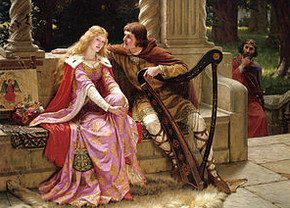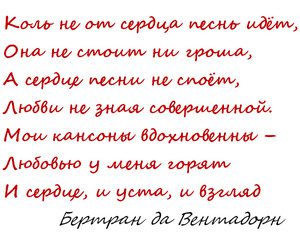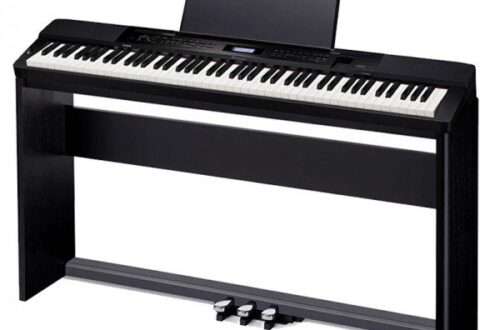
The art of troubadours: music and poetry
Contents
 The word “troubadour” is translated from the Provençal language as “to find”, “to invent”, because melodies and songs are a kind of finds and inventions. Mostly troubadours – traveling musicians – performed their own songs and only a few, having composed a song, entrusted their performance to a juggler.
The word “troubadour” is translated from the Provençal language as “to find”, “to invent”, because melodies and songs are a kind of finds and inventions. Mostly troubadours – traveling musicians – performed their own songs and only a few, having composed a song, entrusted their performance to a juggler.
The troubadour movement originated in Provence, the southeastern “historical” region of France, but over time it began to spread in the north of France (where they later became known as trouvères), and also in Italy and Spain. History has preserved the names of the first (conditionally) troubadours – these are such masters as Guiraut Riquier, Goselm Fedi, Guiraut de Borneil, Peyre Vidal.
Many researchers agree that the very, very first representative in this art was nicknamed “Troubadour”. Thanks to his aristocratic origins, he received an excellent education for those times, and, believe it or not, at the age of eight he could read, write and communicate in Latin.
 According to contemporaries, Guillaume’s first poems were written at the age of 10, and since then the muse has accompanied the future great poet and singer. Although not distinguished by great success in military affairs, the Duke had great abilities for playing music and loved dancing and acting. The Duke’s last passion brought him into conflict with the church (we are talking about the medieval era).
According to contemporaries, Guillaume’s first poems were written at the age of 10, and since then the muse has accompanied the future great poet and singer. Although not distinguished by great success in military affairs, the Duke had great abilities for playing music and loved dancing and acting. The Duke’s last passion brought him into conflict with the church (we are talking about the medieval era).
Researchers note the perfection of the forms of his poems, and therefore it is believed that it was Guillaume who gave impetus to the further development of not only the poetry of the troubadours, but also European poetry in general.
It is curious that the Occitan (in other words, Provençal) language, in which the troubadours composed their works, was the only literary language in many regions of Italy and Spain in the medieval era.
Who could become a troubadour?
Among the troubadours there were many well-educated people. Mostly, troubadours became humble knights who were patronized by overlords – large feudal rulers. Famous lords and ladies of Provence and Languedoc sought to patronize talented artists who were fluent in the art of troubadours. Court musicians at that time were required to have the following skills:
- play any musical instrument;
- compose poetry impromptu for those of higher status;
- keep abreast of the latest news at court.
Other famous troubadours
In addition to the already mentioned Guillaume Aquinas, the European Middle Ages put forward a number of other names of famous troubadours:
- – a troubadour, whose poetry is full of sensuality and adventurism, a famous improviser of love canzones and political sirvents (these are the genres of troubadour creativity).
- – French trouvere who took part in the Crusades. Only a few of his poems have survived – mostly courtly canzones, camp songs and satires.
- – the son of an ordinary servant, who became a famous poet of his time (XII century), in his poems he sang of spring and love as the greatest good.
Famous troubadours are not exclusively men; in the Middle Ages there were also female poets – there are currently 17 known female troubadours. The name of the first among them is
Courtly themes in the art of troubadours
At the end of the 11th century, the so-called courtly poetry of the troubadours arose – knightly poetry, in which a loving, but at the same time courteous attitude towards a lady was cultivated. She is presented in such verses as a kind of ideal, likened to the image of the Madonna, at the same time we are talking about a lady of the heart who needs to be glorified and loved with platonic love.
The role of such a lady of the heart was most often played by a married woman, and often long chanting of the beautiful lady was in fact a prelude to intimacy, enclosed within certain rules and frameworks; long courtship in this cultural context meant high status for the suitor.
The cult of the beautiful lady had a significant impact on the attitude towards women, because before that the church presented the female sex only as a breeding ground for sin and debauchery. Also, thanks to courtly culture, love marriages began to take place.
The influence of troubadour art on musical culture
The art of the troubadours indeed influenced the further development of European culture in general and music in particular. The music composed by troubadours influenced the development Minnezanga – German knightly poetry. Initially, the minnesingers simply covered the compositions of the troubadours, and a little later in Germany they formed a separate type of musical creativity – minnesang (this word literally translates as “love song”)
You should know about some specific genres that were formed in the music of troubadours:
- Pastoral – this is a song genre, the content of such a song is usually unpretentious: a knight talks with a simple shepherdess, and, unlike courtly poems, there can be no talk of any high feelings; under the guise of flirting, only issues of “carnal love” are discussed.
- Alba is a song in which the situation of lovers parting in the morning is poeticized: they have to part, perhaps forever (the knight could die in battle) with the arrival of dawn.
- the canzona – a love song addressed to a girl, but sometimes the singing of a canzona simply expressed respect for the overlord, girl or friend; in such cases, the canzona could be performed by several knights at once.





